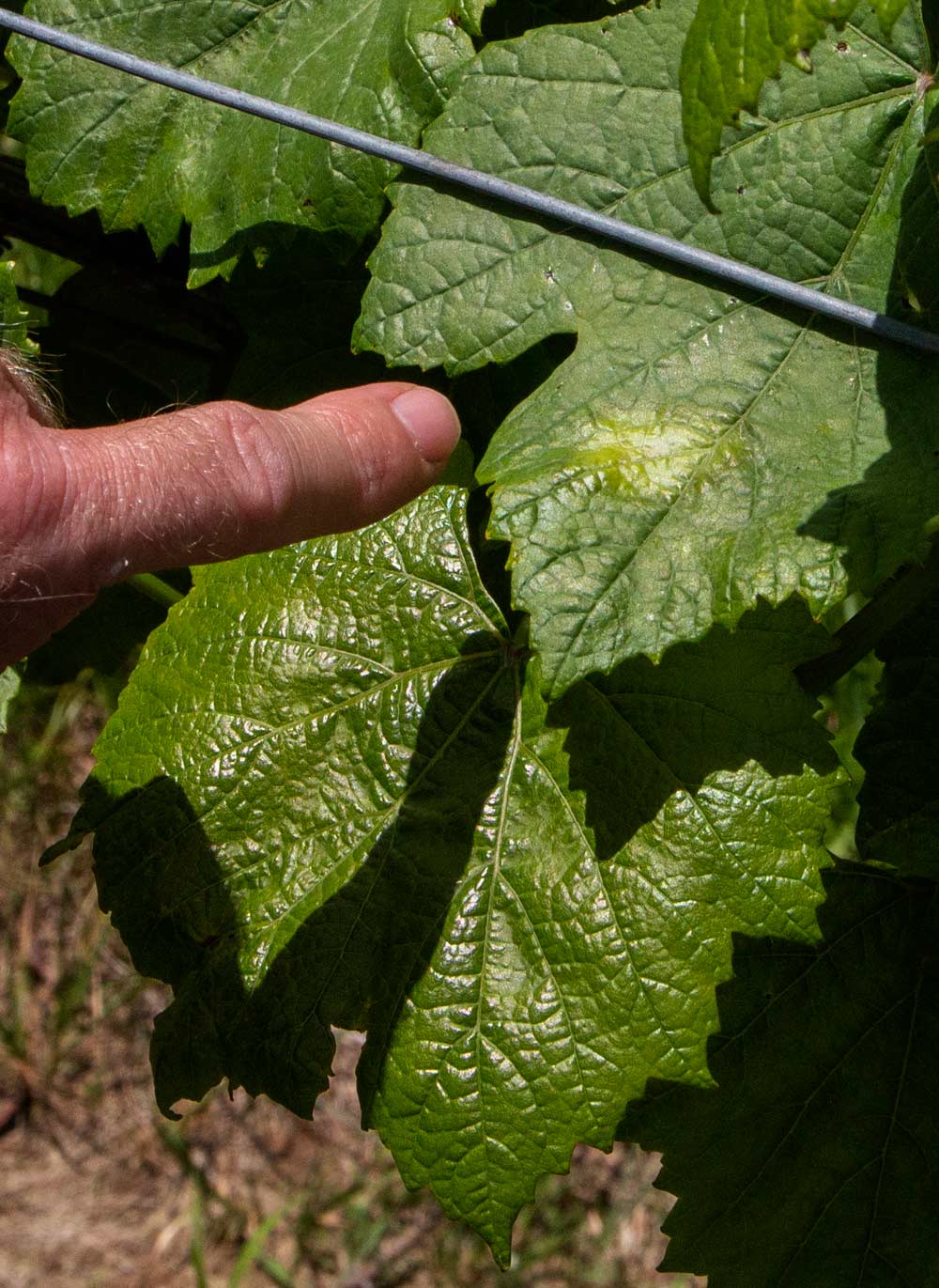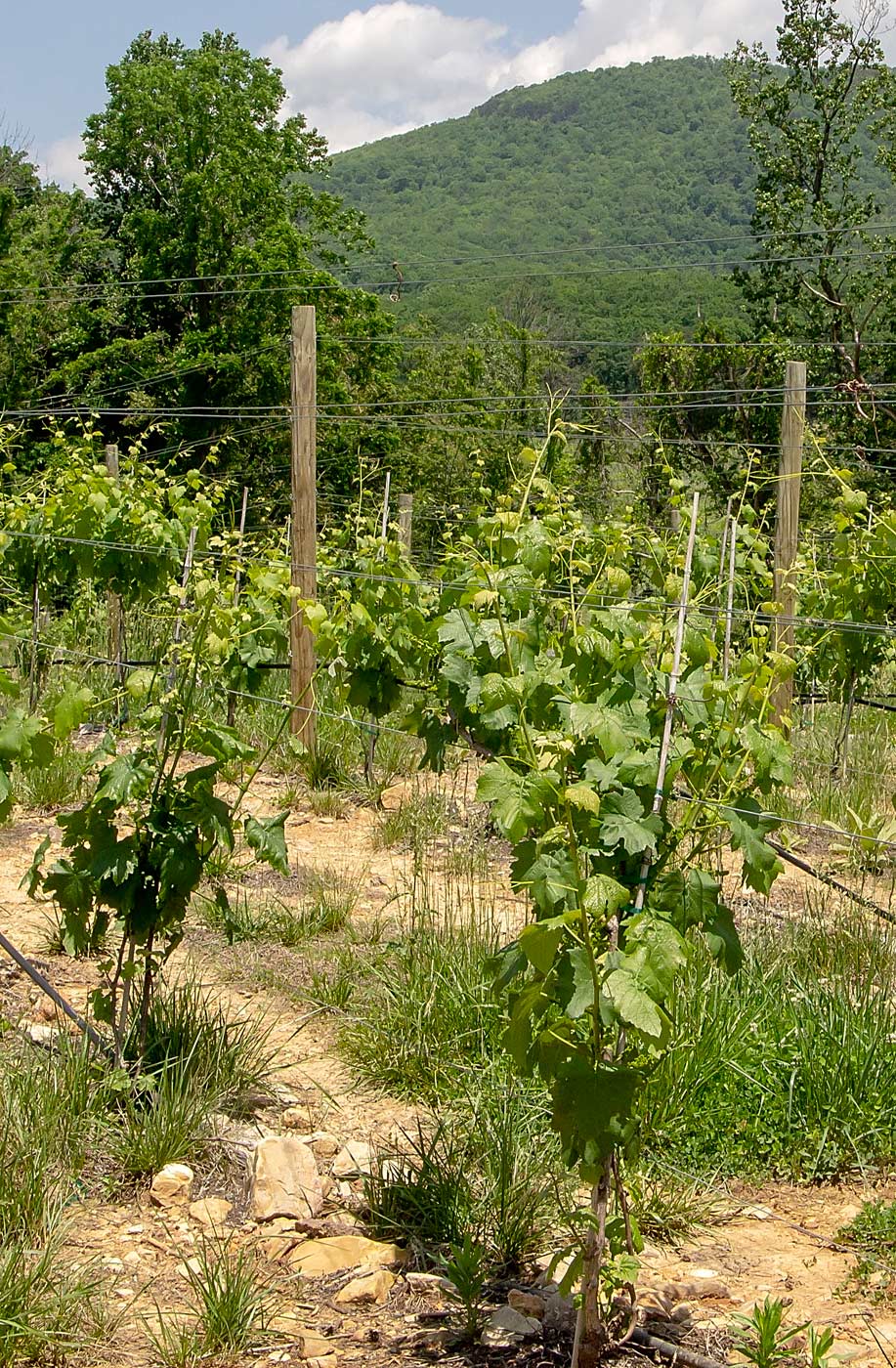
Good vineyard sites in Virginia need good relative elevation and well-drained soils, such as Brown Bear Vineyards in Woodstock, situated in the foothills of the Blue Ridge Mountains. (Kate Prengaman/Good Fruit Grower)
Wine tourism is booming business in Virginia, but growers there have been challenged to grow high-quality wine grapes, given the region’s hot, humid summers and rich, clay soils.
Over the past five years, the state has planted hundreds of new acres, bringing the total land planted in vineyards to 3,600 acres, supporting 280 wineries, most of which is sold “through the cellar door,” said Tony Wolf, viticulturist and director of the Virginia Tech Alson H. Smith Jr. Agricultural Research and Extension Center in Winchester, Virginia.
“It’s an expensive place to be growing grapes,” he said, given the disease pressures, climate and high land prices, but he’s spent more than 30 years figuring out how growers can use the right sites (if it’s good for peaches, it’ll be good for grapes), right varieties and right canopy management to produce wine grapes worth drinking.
Now, wine is a $1.37 billion industry, according to a recent state study, and Virginia ranks sixth nationally in wine grape production.
Most vineyards are under 10 acres, due to the constraints of topography, and owned by boutique wineries or hobbyists, but a few independent growers are also scaling up production to meet demand from wineries and capture some economies of scale.
“It’s tough to make a buck unless you get large. But we’re in the foothills of the Blue Ridge Mountains, so we’ve got terrain challenges that make it hard to find large tracts of land to develop vineyards on,” said Tom Kelly, manager of Brown Bear Vineyards, one of the state’s largest independent vineyards at 57 acres and a longtime viticulture consultant in the region. “But there’s a very high demand for fruit in Virginia right now. In 2014, we embarked on an expansion project that doubled our acreage.”
They aren’t the only ones. Across the region, lots of new acreage will come into production in the next few years, said Nate Walsh, president of the Virginia Vineyards Association.
“Assuming we have good vintages, grape production will be catching up with the demand from wineries, and wineries will be able to start operating more nationally,” said Walsh, who makes wine and manages about 35 acres of vineyards in Northern Virginia for Walsh Family Wine.
There’s not yet a defining grape for the region, such as Riesling has become for the Finger Lakes in New York, Walsh said, because the good vineyard sites tucked into the different regions of the state vary so much in terms of elevation, soils and climate.
“When vineyards are planted thoughtfully on a site that has good elevation and good drainage, we can grow and ripen medium season varietals very well,” he said. Top varieties are Bordeaux reds, including strong Cabernet Franc performance, along with Chardonnay and Viognier. “The difficulty here is it’s humid so we need thick skins and loose clusters and disease protection.”

Tom Kelly, manager of Brown Bear Vineyards, points to an oil stain spot that indicates the early development of downy mildew. Due to the hot, humid weather, downy mildew and powdery mildew are constant challenges for Virginia vineyards. (Kate Prengaman/Good Fruit Grower)
Brown Bear
The lush green forest that surrounds Brown Bear Vineyards in Woodstock, Virginia, is a constant reminder that this is a region that gets 40 to 50 inches of rain a year. So is the vigorous grass growing beneath the vines.
“Mowing is a critical part of our IPM,” said Kelly. “We need grassy middles to prevent erosion, but if it gets out of control, it increases our disease pressure. Mowing is a necessary operation to reduce moisture, because keeping the grass short lets the grass dry out.”
But drip lines also run below the VSP-trained rows. Irrigation is rare in Virginia, but Kelly says it’s important to the establishment of the vineyard, and regular water helps bring a block into production a year or two earlier. “After that, it’s an insurance policy,” he said.
Another insurance policy is 8 acres of Vidal Blanc. The French-American hybrid variety is less desired by winemakers than the European cultivars that dominate the vineyard and pays $1,000 less a ton. But Kelly says they actually make more money on Vidal Blanc than Chardonnay because they can crop it at 7 to 8 tons per acre and still ripen it well, compared to 4 tons per acre for Chardonnay.
“One of the nice things about having hybrids here in our climate is that they are fruitful from the secondary buds, so if we do have a frost that damages the primary buds, we’ll still have a crop,” Kelly said. “And in the hands of the right winemaker, they make some exceptional wines.”
A Petit Verdot block planted in 2015 has the prime location in the vineyard on a scenic hilltop so rocky that heavy, rock-breaking equipment was needed to put in posts and plants. The site provides excellent water and cold air drainage — and one of Kelly’s favorite views.
Planting on the rocks made sense viticulturally, but from a management perspective, it’s been a challenge since the rocky soil is so hard on equipment. “We didn’t realize how big of a problem it was going to be,” he said. “But the grapes love it.” Kelly plans to run a tractor mounted rock-crusher through the block soon to attempt to smooth out the aisles somewhat.
Labor presents another challenge, as it does for fruit growers everywhere, but it’s especially hard for small vineyards to justify the costs of investing in mechanization or guest workers. Instead, he hires a local contract crew regularly throughout the season for pruning, shoot thinning and harvest. There’s an old harvester in the shop, but only in case of emergencies like an approaching hurricane near harvest, Kelly said.
Also in the shop: a shiny, new $40,000 leafer, which uses pulses of compressed air to thin the canopy, and a recycling sprayer that sucks in any material that blows through the canopy.
“We stretch a tank about 30 percent further because we’re recapturing everything that goes off target,” Kelly said. In a region where a dozen fungicide covers is the norm, that makes a difference in the bottom line. And he expects the leafer, making two passes a season, to be a huge labor savings.
Like mowing, leafing and shoot thinning are critical to creating the open canopy that encourages light penetration and air flow and reduces disease pressure.

The rocky, well-drained soil on this hilltop at Brown Bear Vineyards, in contrast to the clay soils found in most of Virginia, make it an ideal site for premium grapes, such as this Petit Verdot block. (Kate Prengaman/Good Fruit Grower)
Growing an industry
All the fruit that Kelly grows is contracted out for the next 20 years to four wineries that invested in the expansion planting several years ago.
Those type of contracts are increasingly common as Virginia wineries look to grow and take advantage of the agricultural tourism potential in the region, said both Walsh and Wolf.
“Where I see the growth occurring is vineyards with wineries behind them,” Wolf said. “If you just go with the market, Petit Verdot is going for $2,300 to $2,400 a ton. So, you need to get to 5 or 6 tons per acre to justify that investment. But wineries that need grapes are putting their equity into vineyards.”
There’s still room for lots of growth in terms of promising vineyard sites yet to be developed, Walsh said, but there’s also opposing forces from development, high land prices and competition from other farmers that make up Virginia’s diverse agricultural sector.
There’s relatively low pressure from insect pests. But constant pressure from fungal diseases including downy mildew, powdery mildew, leaf spot, botrytis bunch rot, black rot and ripe rot, along with an emerging concern about grapevine leafroll virus, keeps Virginia Tech pathologist Mizuho Nita busy.
Despite all the challenges, Virginia vineyards can make great wine that intrigues consumers and keeps them coming back, Kelly said.
“One of the things I really like about Virginia wines is the diversity vintage to vintage. Unlike California, we are much more analogous to the Old World growing regions where every year is a different year,” Kelly said. “We are constantly challenged to look at what Mother Nature hands us growers to produce the best fruit we possibly can. So, in that way we’re well suited to advanced wine tasters looking for that vintage variation and finding those years that are an absolute treasure.” •
—by Kate Prengaman






Leave A Comment